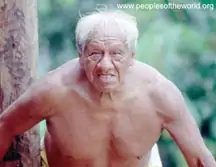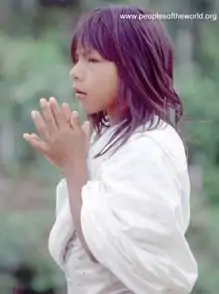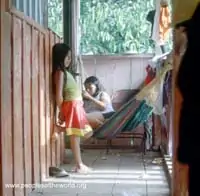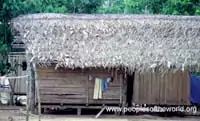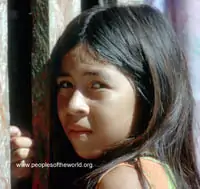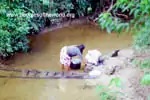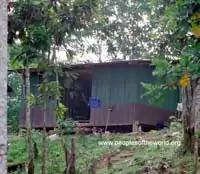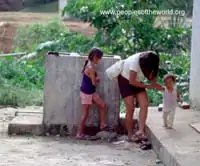The Indigenous Huaorani People
Ethnonyms: Auca, Auishiri, Huao, Sabela, Waodani, Waorani Countries inhabited: Ecuador, Peru Language family: Unclassified Language branch: Unclassified
What do the indigenous Huaorani people and crude oil have in common? It might seem like a strange question, but the answer is both detailed and relevant. It sheds light on the Huaorani themselves and also on some of the forces that are familiar to us, but which have yet to play out in many parts of the world and threaten indigenous human populations in the way they have threatened the Huaorani — and continue to do so.
First, the Huaorani and crude oil were "discovered" around the same time in the Ecuadorian Amazon Basin. Second, in both cases, upon learning of their discovery many in the Western world were interested. Of course, there was very little overlap between the groups interested in each of these discoveries. Third, like the oil, there will come a time when the Huaorani are not counted among the rainforest's "natural" resources.
The Huaorani first came into contact with non-Huaorani (or cowode as they refer to outsiders) in the late-1940s. The oil company, Shell, had begun the first exploratory drilling on ancestral Huaorani lands.
They very quickly abandoned the effort due to the overwhelming fierceness they experienced from their "hosts." (The term Auca is actually the name the Quichua give to them, which translates roughly into English as "savage.")
Further contact took place in the mid-1950s. This time it was Christian linguist missionaries who, according to their later published claims, were motivated by the threat of extinction the Huaorani faced due to fierce intertribal conflict and the certainty of eventual further oil exploration.
This contact was not initially successful either. In 1956, five missionaries were killed by the Huaorani, who viewed them as invaders. Around that time, one of the murdered missionary's sisters, Rachel Saint, achieved what would become, for the most part, peaceful contact for the rest of her life. (Saint's story is well documented; see the Citation and References section at the bottom of this page.)
A lot of her life was spent learning, and contributing to our linguistic understanding of, the Huaorani language. (Their language has defied classification by linguists.) Her informant in learning the language was a young Huaorani woman named Dayuma. Between them, they began missionary work, reaching many of the Huaorani around Dayuma's home. They are still more responsible than any others for missionizing the Huaorani.
In the late-1960s, the oil company, Texaco, received permission from the Ecuadorian government to drill for oil on Huaorani land. Massive displacement of hundreds of Huaorani followed. Saint and Dayuma played a key role in helping the displaced Huaorani to relocate. Before then, most had remained on their ancestral lands, uncontacted, and living the same hunting/gathering lifestyle that hadn't changed in millennia.
What is known about this lifestyle is that the Huaorani cultivated almost no crops or plants, and they relied on hunting for their meat and fish. They were experts in, and had a symbiotic relationship with, the rainforest.
That relationship transcended into the spiritual. Shamanism was practiced, which included the use of naturally-occurring hallucinogens. Animistic ritual and polygamy also characterized traditional Huaorani practices. They believed in a symbolic relationship between their environment and themselves. The forest would always provide enough that they didn't have to grow food or keep animals. Leaves were like their children.
They believed strongly in their history of, and their desire for, independence. In fact, at the age when our children enter second grade, Huaorani children became, to a large extent, independent of their parents — even hunting and gathering their own food.
The missionaries and the Ecuadorian government agreed to relocate as many Huaorani as possible. They were moved away from the drilling areas to the missions that had been established in the previous ten years. Hundreds were relocated, while others fled to even more remote parts of the jungle.
Accounts of the relocated Huaoranis' experiences differ. At one extreme, some have written of this event as "ethnocide." Others have claimed that it saved the Huaorani from genocide at the hands of the oil companies. An unquestionable outcome is that many had their life and culture changed forever, while others chose (and in some cases were never presented a choice) to stay deep in the rainforest and continue living the same way they'd only ever known.
The visitor can see this polarization today in Ecuador. Eventually, many missionized Huaorani moved to so-called oil frontier towns, particularly Coca. Spanish is now their first language; drug and alcohol abuse rates are high.
On the other end of the spectrum, two groups remain virtually uncontacted to this day. The Tagaeri and Taromenane clans (who are believed to live together these days) still live the way they always have — entirely off the land. The Tagaeri are known for killing, by spears, trespassers on their land in 1987, 2000 and 2001.
Although they have been successful in avoiding contact, with their number undoubtedly low, one has to wonder whether their gene pool can be viable for much longer. (The best population number available is 37, as reported by a Tagaeri woman who was kidnapped in 1993 by other Huaorani.)
Viability of the gene pool is not only a concern for uncontacted Huaorani. Before I visited communities around Tiguino, I was informed of cases of physical deformity due to incestuous reproduction — although I didn't witness that myself.
Living on the edge of Huaorani territory, these communities live next door to colonists comprising many ethnic groups, who moved in following the construction of the "Via Auca" by Texaco in the past sixty years. There has been, however, little intermarriage with these other groups.
The contacted Huaorani today differ widely in the dealings they wish to have with outsiders. Some embrace tourism and work with tour companies they trust. The visitor can witness in their villages rainforest survival little changed by time. Others see tourism as a threat similar to the encroachment of the oil companies.
To the extent that the contacted Huaorani have a unified voice regarding the threats to their livelihood, it is through the Organization of the Huaorani Nation of the Ecuadorian Amazon (ONHAE). Founded in 1990, ONHAE represents Huaorani communities in issues such as land rights and education.
The Huaorani differ widely in their experience of education also. It is remarkable that only three generations after their "discovery" some today are educated to university level. While a few Huaorani children are still self-sufficient hunter/gatherers, over half attend school. Still, as shown in the picture, above, facilities are extremely basic. Children are usually taught in Spanish, since their teachers don't speak their language. Not surprisingly, many never progress beyond the first few grades.
As isolated indigenous groups the world over continue to be assimilated into surrounding cultures, governments, non-governmental organizations and aid agencies alike can learn many lessons from the experiences of the Huaorani.
Photography copyright © 1999 - 2025, Ray Waddington. All rights reserved. Text copyright © 1999 - 2025, The Peoples of the World Foundation. All rights reserved.

Waddington, R. (2003, revised edition 2024), The Indigenous Huaorani People. The Peoples of the World Foundation. Retrieved December 13, 2025, from The Peoples of the World Foundation. <https://www.peoplesoftheworld.org/text?people=Huaorani>
Web Links Rachel Saint Die Huaorani (auf Deutsch) Los Huaorani (en español) Books Ethel, E. W., (1996) Dayuma, Life under Waorani Spears: A Tragedy that Shocked the World, a Vision that Refused to Die. Seattle: YWAM Publishing. Kane, J., (1995) Savages. New York: Knopf. Kimerling, J., (1991) Amazon Crude. New York: Natural Resource Defense Council. Smith, R., (1996) Drama under the Amazonian Mantle. Quito, Ecuador: Abya Yala. Elliot, E., (1957) Through the Gates of Splendor. New York: Harper.
